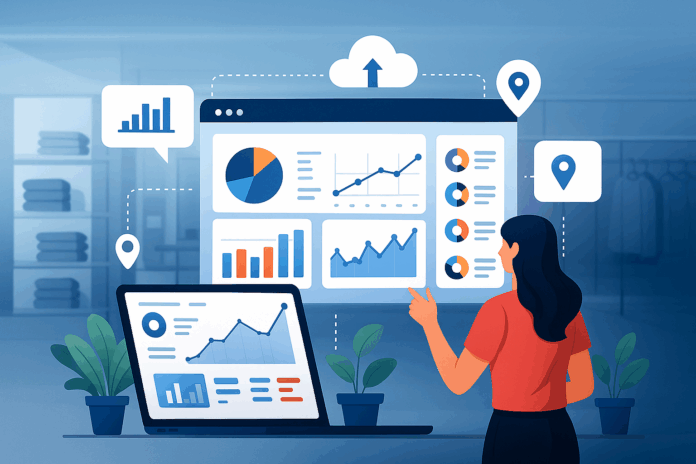In an era where customer expectations evolve daily and competition stretches across digital and physical channels, retail success depends on one decisive factor: how well a business uses its data. A data-driven strategy empowers retailers to make smarter, faster, and more profitable decisions. From inventory and pricing to customer engagement and forecasting, the retailers leading today’s transformation aren’t guessing — they’re analysing.
Introduction
Technology, data, and consumer empowerment shape the modern retail landscape. Every transaction, online click, or in-store visit creates a wealth of information that can unlock insights into buyer behaviour, supply chain efficiency, and market dynamics. Yet, despite the availability of such information, many businesses still rely on outdated intuition or fragmented systems to make crucial decisions.
A data-driven strategy changes this dynamic entirely. It places analytics at the centre of operations — transforming how decisions are made, resources are allocated, and growth is achieved. According to a McKinsey Global Institute study, companies that base decisions on data are 23 times more likely to acquire customers and 19 times more likely to be profitable than those that do not. Retailers like Amazon, Zara, and Walmart have proven that data intelligence can be the difference between market leadership and stagnation. Below are eight comprehensive reasons every retail business — from local chains to global brands — needs to make data its guiding compass.
1. Deeper Customer Understanding and Personalization
Why It Matters
Every successful retail business begins and ends with the customer. Understanding who they are, what they buy, and why they return defines the essence of retail competitiveness. A data-driven approach enables brands to go beyond basic demographics — analysing behavioural patterns, emotional triggers, and micro-moments of decision-making.
Retailers like Amazon and Netflix have built empires on hyper-personalisation. By analysing browsing history, purchase frequency, and product interactions, they create dynamic recommendation engines that adapt to each customer’s preferences. Traditional retailers are following suit: Tesco Clubcard data, for instance, enables the company to segment its 20-million-strong customer base and deliver tailored offers that increase loyalty and basket size.
Key Benefits
- Segmentation and Profiling: Grouping customers by behaviour, value, and intent allows precise targeting.
- Personalised Marketing: Tailored product suggestions, email campaigns, and promotions drive engagement.
- Enhanced Experience: Customers feel recognised, valued, and understood, which builds long-term trust.
In Practice
Retailers can collect first-party data from point-of-sale (POS) systems, e-commerce platforms, and loyalty programs. Using predictive analytics, they can anticipate individual customer needs — whether it’s replenishment reminders, seasonal recommendations, or personalised offers based on location.
Example:
Luxury fashion brand Burberry integrates data from online behaviour, in-store tablets, and social media to build 360-degree customer profiles. When a returning shopper walks into a store, sales associates already know their previous purchases and preferences — enabling an experience that feels exclusive yet effortless.
2. Smarter Inventory and Supply-Chain Management
Why It Matters
Retailers juggle the constant tension between having too much stock and too little. Overstocking ties up capital, leads to markdowns, and increases waste; understocking risks missed sales and disappointed customers. A data-driven supply chain provides real-time visibility and foresight.
Key Benefits
- Demand Forecasting: Predict which products will sell and where.
- Operational Efficiency: Reduce storage costs and avoid excess inventory.
- Supplier Coordination: Anticipate delays or shortages before they affect the customer.
In Practice
Retailers like Walmart and Target leverage data analytics to forecast demand across thousands of SKUs and hundreds of locations. Their systems combine sales data, weather patterns, holiday trends, and even social sentiment to optimise stock allocation.
Zara, a leader in fast fashion, has turned data-driven logistics into an art form. Its distribution model collects daily sales data from stores, feeding insights to designers and production teams who respond within weeks — not months. This responsiveness keeps Zara’s collections fresh and reduces inventory risk.
Implementation Steps
- Integrate data from POS, online stores, and supply-chain sensors.
- Use predictive tools to automate reordering thresholds.
- Apply real-time dashboards to track shipments and detect bottlenecks.
By combining historical and live data, retailers can align their operations with true demand, minimising waste while maximising sales.
3. Optimized Pricing and Promotion Strategies
Why It Matters
Price is both a science and an emotion. A few cents’ difference can shift consumer perception, influence profit margins, or determine brand loyalty. Data-driven pricing empowers retailers to adapt prices dynamically, respond to competitors, and design promotions that attract without eroding margin.
Key Benefits
- Dynamic Pricing: Adjust prices based on demand, seasonality, or competitor activity.
- Promotion Analysis: Measure which discounts drive incremental sales.
- Margin Management: Protect profitability with evidence-based decisions.
In Practice
Amazon’s algorithm famously adjusts millions of prices daily. By analysing competitor listings, inventory levels, and customer behaviour, it ensures the brand remains competitively priced without unnecessary discounts. Meanwhile, supermarkets like Tesco and Walmart use loyalty and basket data to craft targeted promotions that feel personal rather than generic.
Analytical Tools
- Price Elasticity Models: Identify how sensitive customers are to price changes.
- Competitive Intelligence: Scrape and benchmark competitor pricing.
- A/B Testing: Run experiments on discount structures and evaluate ROI.
By embedding these insights into retail planning, brands can shift from reactive markdowns to proactive optimisation. The outcome is a balanced pricing strategy that drives growth while sustaining profitability.
4. Enhanced Marketing Effectiveness and ROI
Why It Matters
In the digital age, marketing is measurable — but only if you know what to measure. Traditional advertising relied on guesswork; today’s marketing leaders rely on data analytics to justify every pound or dollar spent. With channels from social media to search, retail marketing requires precision.
Key Benefits
- Attribution Clarity: Identify which campaigns or touchpoints truly drive conversions.
- Audience Insights: Learn which segments deliver the highest ROI.
- Performance Optimisation: Reallocate budget from low-impact to high-impact channels.
In Practice
Nike and Sephora use customer data from apps and loyalty programs to craft highly personalised digital experiences. Their analytics teams measure engagement, social buzz, and conversion rates in real time — adjusting campaigns accordingly.
Practical Framework
- Set measurable KPIs — e.g., conversion rate, cost per acquisition, lifetime value.
- Integrate campaign data across all platforms (email, social, in-store).
- Use marketing automation tools to refine targeting and timing.
- Review dashboards weekly to identify under-performing campaigns.
Example
Coca-Cola’s data-driven marketing analyses customer engagement across 200+ countries, enabling the company to adapt messaging instantly to local sentiment. Retailers can replicate this agility by linking online analytics to store-level sales outcomes, ensuring every marketing dollar contributes directly to the bottom line.
5. Better Operational Efficiency and Cost Control
Why It Matters
Every inefficiency — whether a delayed shipment or an overstaffed store — affects profit. A data-driven retail model eliminates waste by revealing patterns invisible to the naked eye. Analytics streamline workflows, reduce costs, and improve resource allocation across departments.
Key Benefits
- Process Optimisation: Identify and eliminate bottlenecks.
- Workforce Planning: Match staffing with peak hours and foot traffic.
- Reduced Waste: Cut markdowns and unsold inventory.
In Practice
Walmart’s “Retail Link” platform grants suppliers real-time access to sales and inventory data, ensuring replenishment happens precisely when needed. Similarly, Target uses predictive scheduling tools to allocate staff based on traffic forecasts, improving productivity and employee satisfaction.
Operational Applications
- Store Layout Analytics: Track customer movement through heat maps to improve product placement.
- Energy Efficiency: Monitor lighting, cooling, and equipment performance.
- Return Pattern Analysis: Identify products prone to returns and adjust sourcing or training.
By converting operational data into actionable intelligence, retailers can reduce overheads while enhancing service quality.
6. Competitive Advantage and Market Responsiveness
Why It Matters
Retail competition is fierce — and the battlefield shifts daily. With consumer trends influenced by viral content, social values, and price transparency, adaptability defines winners. Data analytics equips retailers with the agility to act faster and smarter than their rivals.
Key Benefits
- Trend Detection: Spot emerging categories or product preferences early.
- Real-Time Response: React quickly to competitor pricing or stockouts.
- Strategic Foresight: Use external data to anticipate market changes.
In Practice
Amazon, Zara, and Costco are masters of agility. Amazon tracks competitor movements hourly, Zara monitors in-store demand to trigger microproduction, and Costco uses membership data to refine product assortments and negotiate supplier terms.
How to Build Advantage
- Integrate internal and external data sources (POS, social media, Google Trends).
- Use AI-driven forecasting to test new product ideas.
- Align cross-functional teams around insights, not assumptions.
Retailers who harness real-time intelligence consistently outperform those reacting to outdated data. The faster you can interpret trends, the more you can lead — not follow — the market.
7. Accountability, Measurement, and Continuous Improvement
Why It Matters
Without measurement, there’s no growth. A data-driven culture empowers teams to track, evaluate, and refine performance continuously. It shifts decision-making from intuition to insight, establishing transparency across the organisation.
Key Benefits
- Performance Visibility: Dashboards show progress toward goals.
- Evidence-Based Decisions: Reduce politics and bias in management.
- Continuous Learning: Past data informs future actions.
In Practice
Retailers like Starbucks and IKEA apply performance analytics to monitor everything from customer satisfaction to supply chain resilience. Real-time data dashboards allow executives to intervene instantly when KPIs drift off-course.
Cultural Shifts
- Train employees to interpret data, not just collect it.
- Set shared metrics across departments.
- Reward teams for measurable improvements rather than assumptions.
Accountability strengthens alignment between leadership and staff, ensuring every decision connects back to a quantifiable outcome.
8. Risk Mitigation and Future-Proofing
Why It Matters
Retail faces growing volatility — economic fluctuations, supply disruptions, and unpredictable consumer trends. A data-driven strategy mitigates these risks by turning uncertainty into foresight.
Key Benefits
- Predictive Alerts: Identify potential risks early through anomaly detection.
- Scenario Planning: Model outcomes for various economic or market conditions.
- Resilience Building: Create agility to withstand disruptions.
In Practice
During the pandemic, Walmart and Target leveraged predictive analytics to forecast demand spikes for essentials and rapidly adapt their supply chains. Meanwhile, Home Depot used data analytics to anticipate supply shortages and stock critical products in advance.
How to Future-Proof
- Combine internal analytics with external data (economic indicators, weather, social sentiment).
- Run scenario simulations to test “what-if” conditions.
- Build redundancy in suppliers and distribution channels based on insights.
Data enables retailers not just to survive disruptions — but to thrive through them.
FAQs
1. What is a data-driven strategy in retail?
A data-driven strategy in retail means that every key business decision — from pricing and inventory to marketing and customer engagement — is informed by factual insights derived from analytics rather than intuition. It involves collecting vast amounts of structured and unstructured data across online and offline channels, such as POS systems, mobile apps, CRM platforms, and social media.
By analysing this information with tools like AI, machine learning, and predictive modelling, retailers can understand demand cycles, consumer sentiment, and profitability trends in real time.
This approach helps businesses reduce uncertainty, improve forecasting accuracy, and align every department — marketing, logistics, finance, and sales — around standard performance metrics.
In essence, a data-driven retail model transforms information into strategy, enabling leaders to make consistent, evidence-based decisions that maximise efficiency and growth.
2. How does data analytics improve customer experience?
Data analytics revolutionises the customer experience by allowing retailers to create interactions that are relevant, personalised, and timely. By analysing behaviour such as browsing patterns, purchase history, and engagement across platforms, retailers gain a 360-degree view of each customer.
This intelligence powers personalised recommendations, targeted promotions, and even customised store layouts. For example, Amazon uses recommendation algorithms that increase conversion rates and average order value, while Starbucks tailors app offers based on purchase frequency and time of day.
Moreover, analytics helps brands identify pain points — such as checkout delays, product returns, or poor navigation — and implement corrective actions immediately.
A data-driven approach ensures that every touchpoint, whether online or in-store, feels intuitive and customer-centric. This not only enhances satisfaction but also builds loyalty and long-term advocacy.
3. How can small retailers use data effectively?
Small retailers often believe that data-driven strategies are reserved for large corporations, but that’s a misconception. In reality, even small businesses can unlock significant value from analytics using accessible tools.
Simple actions such as tracking sales performance, monitoring Google Analytics, and maintaining customer databases can yield critical insights into product popularity, seasonality, and purchasing habits.
Affordable CRM systems such as HubSpot, Zoho, or even loyalty card apps can help store and interpret customer data.
For brick-and-mortar retailers, analysing foot traffic patterns and POS data can guide merchandising and staffing decisions.
The goal isn’t to collect massive data volumes, but to focus on relevant metrics that influence daily operations — such as repeat purchase rates, inventory turnover, or conversion rates.
Over time, these insights help smaller retailers compete more effectively against bigger players by improving efficiency and customer engagement.
4. How does data reduce operational costs in retail?
A data-driven retail model enables precise operational monitoring, helping identify inefficiencies and cost leaks across the business. For example, data can reveal overstocking issues, suboptimal delivery routes, or excessive energy consumption.
By analysing supply-chain performance metrics, retailers can reduce fuel costs, optimise warehouse usage, and negotiate better supplier terms.
Predictive analytics also prevents waste by forecasting demand accurately — ensuring products are available where and when needed without excess.
In staffing, footfall data helps allocate employees efficiently, avoiding both overstaffing and service gaps.
Retailers like Walmart and Target use advanced analytics to control logistics expenses and streamline vendor partnerships, saving millions annually.
Ultimately, data eliminates guesswork, enabling decision-makers to invest resources wisely. This continuous feedback loop results in leaner operations, improved cash flow, and stronger profitability across all levels of retail management.
5. What are the risks of ignoring data in retail?
Ignoring data analytics in retail is equivalent to flying blind in a turbulent market. Businesses that rely solely on intuition risk making slow, uninformed decisions that fail to adapt to shifting consumer behaviours or competitive threats.
Without reliable data, retailers may suffer from inventory mismatches, ineffective promotions, and poor pricing strategies — leading to lost sales and eroded margins.
Additionally, competitors who embrace analytics gain a strategic edge, identifying emerging trends and acting faster.
A lack of data governance can also result in fragmented systems, compliance issues, and operational silos, further weakening agility.
As the retail industry becomes more digital and global, failing to leverage data means missing opportunities for automation, personalisation, and customer insight.
In short, data neglect doesn’t just slow progress — it can jeopardise a brand’s long-term survival in an increasingly analytical marketplace.
6. What technologies enable data-driven retailing?
A truly data-driven retail ecosystem relies on an integrated technology stack that combines collection, storage, and analysis. At the foundation are POS systems, ERP platforms, and CRM tools that capture operational and customer data.
Layered above these are cloud data warehouses such as Google BigQuery, Snowflake, and AWS Redshift, which securely store large volumes of structured and unstructured data.
For analysis, businesses use BI (Business Intelligence) platforms like Tableau, Power BI, and Looker to create visual dashboards and actionable reports.
Advanced retailers deploy AI and machine learning models for predictive analytics, demand forecasting, and recommendation engines.
Finally, marketing automation and customer data platforms (CDPs) ensure seamless integration between digital campaigns and offline sales.
Together, these technologies build a unified, intelligent retail operation where every decision is powered by real-time insight rather than outdated intuition.
7. How can retailers measure ROI from their data-driven initiatives?
Measuring the ROI (Return on Investment) of data-driven retail strategies requires linking analytical improvements to financial performance. Retailers should begin by defining baseline KPIs — such as sales growth, average transaction value, inventory turnover, or customer retention.
After implementing analytics solutions, these same metrics can be tracked over time to calculate uplift or savings.
For instance, if predictive analytics reduces stockouts by 10%, that directly translates to revenue preservation. If automation saves man-hours, it’s a measurable cost benefit.
Retailers also assess marketing ROI by attributing sales to specific campaigns or customer segments.
Over the long term, improved forecasting, optimised pricing, and better targeting deliver sustained profitability.
By maintaining transparent dashboards and reviewing results quarterly, businesses can clearly quantify the impact of their investment in data infrastructure and analytics talent on measurable financial success.
Conclusion
The message is clear: in the 21st-century retail environment, data is the new currency. Every purchase, click, and interaction generates actionable intelligence that can drive smarter decisions. From personalisation to supply chain optimisation, pricing, marketing, and risk management, a data-driven strategy empowers retailers to align every function with measurable outcomes.
Retailers that invest in analytics infrastructure, talent, and culture today will define the competitive landscape tomorrow. The shift is not about collecting data, but about using it intelligently — turning numbers into narratives, and insights into impact. Those who master that art will lead the next generation of global retail.









